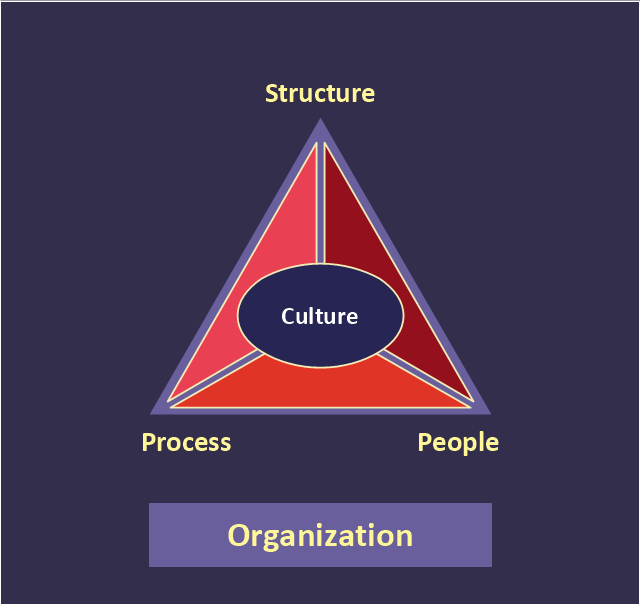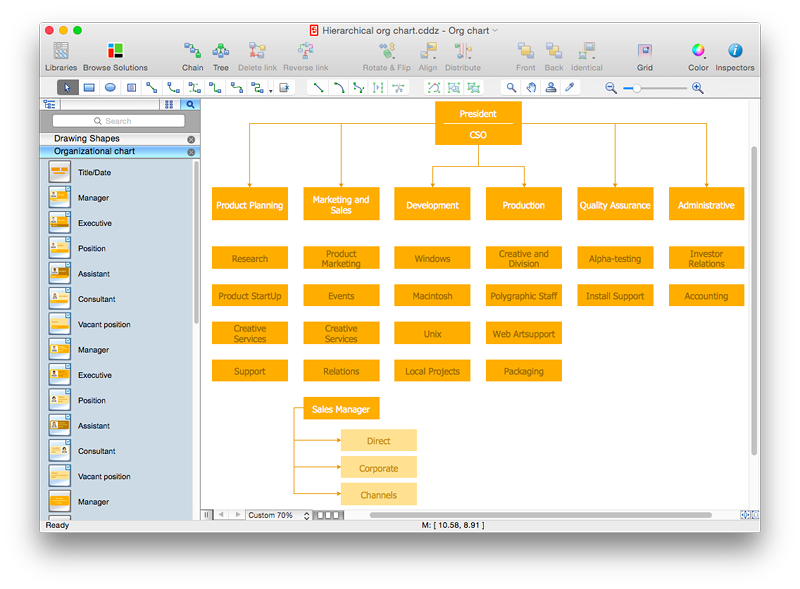"At the base of the identity of an organisational is its organizational culture. A culture is comprised of the shared values, customs, traditions, rituals, behaviours and beliefs shared by a social group (national, ethnic, organizational, etc.). Cultures also share languages, or ways of speaking. From a communication perspective, cultures are made and remade through the words we use to describe our world. Culture represents a common set of values (“shared meanings”), shared by members of a population, a organization, a project/ programme purpose unit or a profession (e.g., engineers versus scientists). Culture change with the times but the speed at which the culture of different institutions change varies widely." [Development Cooperation Handbook/ The development aid organization/ Organizational Culture. Wikibooks]
This organizational culture triangle diagram example derived from Parker and Benson's model. It's for explaination of the Regatta: Adoption Method.
The pyramid diagram example "Organizational culture" was redesigned using the ConceptDraw PRO diagramming and vector drawing software from Wikimedia Commons file Organization_ Triangle.png. [commons.wikimedia.org/ wiki/ File:Organization_ Triangle.png]
This file is licensed under the Creative Commons Attribution-Share Alike 2.5 Generic license. [creativecommons.org/ licenses/ by-sa/ 2.5/ deed.en]
The triangular chart sample "Organizational culture" is included in the Pyramid Diagrams solution from the Marketing area of ConceptDraw Solution Park.
This organizational culture triangle diagram example derived from Parker and Benson's model. It's for explaination of the Regatta: Adoption Method.
The pyramid diagram example "Organizational culture" was redesigned using the ConceptDraw PRO diagramming and vector drawing software from Wikimedia Commons file Organization_ Triangle.png. [commons.wikimedia.org/ wiki/ File:Organization_ Triangle.png]
This file is licensed under the Creative Commons Attribution-Share Alike 2.5 Generic license. [creativecommons.org/ licenses/ by-sa/ 2.5/ deed.en]
The triangular chart sample "Organizational culture" is included in the Pyramid Diagrams solution from the Marketing area of ConceptDraw Solution Park.
HelpDesk
How to Draw a Hierarchical Organizational Chart with ConceptDraw PRO
There are a number of different organisational structures. The most appropriate structure will depend on the size of the business and the type of business. A hierarchical organizational structure is one of the most typical organizational structure. This structure can be represented as a pyramid, with a single entity in authority at the top, with subsequent levels of power beneath them. Each member of the pyramid reports only to their direct subordinates or superiors, limiting the amount of communication overhead, which can be seen both as an asset or a limitation. It is easy to see where a hierarchical structure would be an effective solution; companies that have offices based in disparate locations, a business that focuses on diversified markets, any organization with need for multiple levels of middle management. You can easily create a clear hierarchical organizational chart using ConceptDraw solution that contains templates of the 25 Typical Orgcharts.- How to Draw an Organization Chart | Examples of Flowcharts, Org ...
- 25 Typical Orgcharts | Organizational Charts | Pyramid Diagram | 5 ...
- Pyramid Diagram | Pyramid Chart Examples | Pyramid Diagram ...
- Pyramid Diagram | Organization triangle diagram | Examples Of ...
- ConceptDraw Solution Park | Organizational Charts | Pyramid Chart ...
- Pyramid Diagrams | Pyramid Diagram | Organizational Charts with ...
- Pyramid Diagram | Organizational culture - Triangle diagram ...
- Pyramid Diagram | Pyramid Diagram | Organizational Charts with ...
- Pyramid Diagram | Organizational Structure | Pyramid Diagram ...
- Pyramid Diagram | How to Draw an Organization Chart ...
- How to Draw a Hierarchical Organizational Chart with ConceptDraw ...
- Pyramid Diagram | Organizational Structure | How to Draw an ...
- Organizational Structure | How to Draw an Organization Chart ...
- Marketing and Sales Organization chart . Organization chart Example
- Pyramid Diagram | How to Draw an Organization Chart ...
- Organizational Structure | Pyramid Diagram | Basic Flowchart ...
- Organizational Structure | Matrix Organization Structure | Pyramid ...
- Pyramid Diagram | Process Flowchart | Pyramid Diagram | Chart Of ...
- Pyramid Charts | Organizational Charts with ConceptDraw PRO | 25 ...

